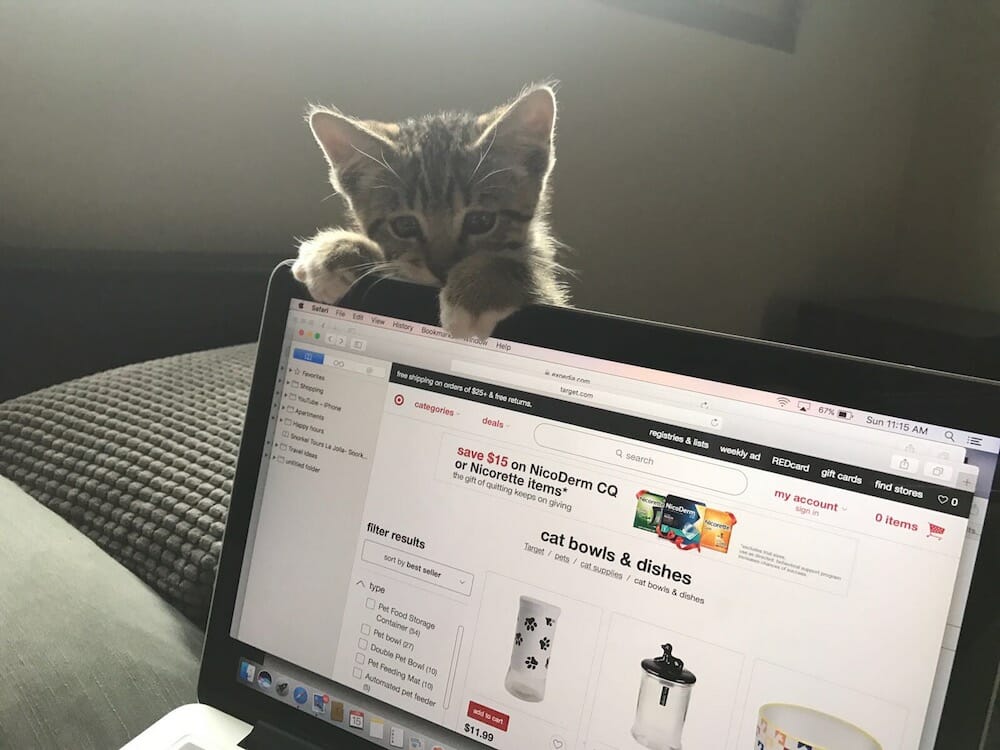Congratulations, you’re considering welcoming a furry new member to the family! This article is a helpful guide for first-time pet owners or people who are considering bringing home a new pet. Before you make the big decision, there are a few factors to consider to make sure integrating a new cat or dog into your life goes as smoothly as possible. Find out the top new-pet owner tips, what supplies you will need, how to create a space for your pet, and more.
New pet owner tips
Along with choosing dog and cat beds, food and supplies, the first thing to consider when preparing your home for a new pet is how to make sure they feel safe, welcomed and loved as quickly as possible. Consider rearranging your schedule or working around some of the busier times in your life to coordinate your pet’s arrival to their new home for a time when you have the availability to give them lots of attention. That way you can get to know each other quickly, feel comfortable and enjoy spending some real time with each other. If you’ve got other pets, make sure you give them lots of attention too or they could easily get jealous.
Remember that when you bring a new pet home they are likely to need some time to adjust. Your home will have different smells and noises than the shelter or home where your pet came from. If you’re introducing a cat to your household, look out for signs of stress such as eating less, cleaning themselves less or sleeping in unusual locations. Stressed cats are also more likely to hide, behave aggressively or show a lack of interest in physical affection. Stressed dogs are prone to whining, hiding and acting subdued. While some of these symptoms can be expected, watch out for your pet’s happiness and make them feel as comfortable and welcomed as quickly as possible to ensure they settle back into their bright selves quickly.
Quick Tip: When you first bring home your pet, it’s totally normal for them to need some time to adjust. Click here to read our guide to adopting a shelter dog, and here to read our guide to adopting a shelter cat.
Supplies for your new pet

An easy way to welcome your new pet is to gather all of the supplies you need beforehand to make sure the transition goes as smoothly as possible.
Checklist for a new cat:
- Food and water bowls
- Food and treats
- Collar with ID tag
- Bed
- Toys
- Brush
- Litter box and litter
- Scratching post
Checklist for a new dog:
- Food and water bowls
- Collar with ID tag
- Food and treats
- Bed/crate
- Toys
- Brush
- Leash
The above lists are a general indication of the supplies you will need for a new cat or dog. It’s best to stick with the same brand of food/litter box during the adjustment period so that your animal won’t have to change everything at once. After they’re settled in, feel free to upgrade to a better quality of food or litter box lining.
Quick Tip: Think about all of the supplies you will need for your new cat or dog and get everything ready before they arrive. Click here to read our complete list of things you’ll need for a puppy starter kit.
Your new pet’s space: bringing home cats and dogs

When bringing a new cat into a home, consider keeping them in one room until they adjust, and then letting them into the rest of the house after a few days. Prepare your home by creating a food/water station, a few hidey holes/places to sleep and installing a scratching post. Setting up a food and water station in your home allows you and your cat to quickly establish a familiar routine, which will help them settle in faster. A great tip for new cat owners is to create a few hidey holes to escape in around the house. This will help your cat feel more safe. You can cut a few holes in a cardboard box and place a towel inside, placing it either on the ground or up high. A scratching post is important to allow your cat to scratch without destroying any furniture.
A cat owner must also decide if your new pet will be allowed outside of the house. While many cats love being outdoors and experiencing their natural environment, an owner owes responsibility to both the cat and the surrounding environment. Cats are natural hunters, and in Australia wild cats can damage the natural ecosystem by preying on native birds and reptiles. Outdoor cats are also exposed to threats such as other cats, dogs, traffic and getting lost. While the decision is up to each individual owner, a safe middle ground lots of owners choose it to create an enclosed space outdoors so that the cat can enjoy the best of both worlds.
When bringing a dog into your home, establish some ground rules before they even arrive. You’ll need to think about if your dog will be permitted in all rooms of the house, if they’re allowed on the couch, and who will be primarily responsible for feeding and walking your pup. At least while your dog adjusts to his/her new home, it’s often a good idea to decide a primary caretaker. This person will be the central figure while your dog adjusts, be his/her alpha and provide a sense of security.
Plan where your dog will sleep at night. Many owners begin with crate training straight away (click here to read our guide to the basics of crate training). This will be a safe place for your dog to hang out and relax in, and is also useful in house training a new puppy. Before bringing home any new pet, but particularly a puppy, you’ll need to think about pet-proofing your home against hazards. Check that there aren’t exposed electrical cords, tasty-looking houseplants or expensive decorative objects that could easily get chewed or damaged. If there are any objects that would be a health hazard to your new pet, you’ll need to store these away. You can also move away laundry baskets, shoes, pest repellants to avoid accidents.
Quick Tip: Decide where your cat or dog will be allowed within your home, and make sure the house is pet-proofed against potential health risks and hazards.
In short…
The key things to remember about bringing home a new pet are to allow time for them to adjust, gather all of the supplies you need beforehand, and make sure you pet-proof your home. New cats especially can take a few days to a week to get used to their new environment, and can display signs of stress such as hiding or under-eating while they adjust. New dogs may be more quiet than usual or contrastingly, very hyped up and overstimulated by a new environment.
Gather all of the supplies you need for a new pet before they arrive, and make sure you set up their living and sleeping spaces. Creating hidey holes for a cat or starting with crate training for a dog are great ways to make sure they have a safe place to sleep and can get some privacy while they adjust. It’s also important to pet-proof your home and make sure there are no exposed wires, poisonous plants or potentially hazardous items that your pet could chew or destroy.
Things to remember about bringing home a new pet
Bringing home a new cat or dog is an exciting time for the whole family, but is also a significant adjustment for the animal as he/she gets used to a new environment. Make sure that you’ve gathered all of the supplies you need for your cat or dog, including food and water bowls, a collar and ID tag, a bed, and toys. When they arrive make sure they feel welcome and loved but give them space to get used to their new home and family too.
Leave a comment
Your email address will not be published. All fields are required.